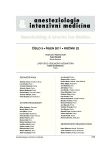EBA recommendations for Safe Medication Practice
(June 2011)
Vyšlo v časopise:
Anest. intenziv. Med., 22, 2011, č. 5, s. 294
Kategorie:
Zprávy ČSARIM
All medications prepared for routine use in anaesthesia, intensive care, emergency medicine and pain medicine should be clearly labelled.
The EBA recommends that pre-filled syringes should be used wherever possible. Hospital pharmacies and manufacturers should be encouraged to supply them particularly in the first instance for high risk medicines and ones administered as infusions that are prone to dilution errors and infection.
The EBA recommends the International Organization for Standardization (ISO) Anaesthetic and respiratory equipment – User-applied labels for syringes containing drugs used during anaesthesia – Colours, design and performance. 1st ed. Geneva: ISO, 2008. ISO 26825:2008(E). The medication name on the user applied label should be matched with the drug name on the ampoule, one medication and one syringe at a time.
In the absence of pre-printed labels for syringes, hand-written ones should be prepared, or syringes should be labelled directly using permanent marker pens.
In an urgent situation if a medication is prepared and immediately administered to a patient with the syringe or container never leaving the hands of the person drawing it up labelling is not required but it is still good practice if there is sufficient time.
Any medicine or fluid that cannot be identified (e.g., in an unlabelled syringe or other container) should be considered unsafe and discarded.
The labelling and packaging of all drugs should facilitate their easy identification. When a drug is available from more than one manufacturer, the clarity of the labelling and the avoidance of look-alike packaging or labelling should be considered when making purchasing decisions. Labelling should conform to applicable national or international standards as these are adopted.
Contamination of any drug must be avoided. To minimise the risk of cross infection between patients the contents of any one ampoule should be administered to only one patient. The use of multidose ampoules is not recommended.
To prevent the transmission of nosocomial infections such as Hepatitis C and Malaria, between patients the use of saline bags with reusable administration ports to provide fluid for drug dilution and syringes for flushing IV lines for more than one patient should no longer take place. Single ampoules of saline or preferably prefilled syringes should be used instead.
Drugs should be stored in ways designed to facilitate their identification and minimize the risk or error of misidentification. Consideration should be given to storing them in their original packaging until just before they are drawn up. Special care should be taken with ampoules that look similar, have similar names, or have labels that are difficult to read.
Adequate, uncluttered surface space and appropriate trays, clean for each patient, should be provided for drawing up, arranging and holding the drugs used in each anaesthetic.
Štítky
Anesteziologie a resuscitace Intenzivní medicínaČlánek vyšel v časopise
Anesteziologie a intenzivní medicína

2011 Číslo 5
- MUDr. Lenka Klimešová: Multioborová vizita může být klíčem k efektivnější perioperační léčbě chronické bolesti
- Neodolpasse je bezpečný přípravek v krátkodobé léčbě bolesti
- Léčba akutní pooperační bolesti z pohledu ortopeda
- Realita léčby bolesti v paliativní péči v Německu
- Perorální antivirotika jako vysoce efektivní nástroj prevence hospitalizací kvůli COVID-19 − otázky a odpovědi pro praxi
Nejčtenější v tomto čísle
- Ultrazvukem naváděný mediální cervikální blok
- Je rozdiel v prežívaní pacientov s kraniocerebrálnym poranením s meraným a nemeraným intrakraniálnym tlakom?
- Mechanismus vzniku hypotenze po i. v. paracetamolu u kriticky nemocných
- Doporučení pro poskytování poanestetické péče
